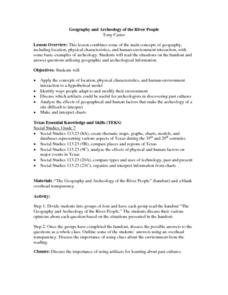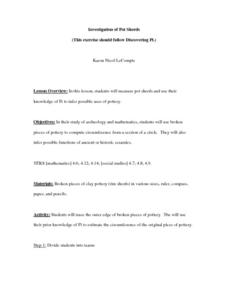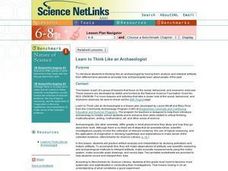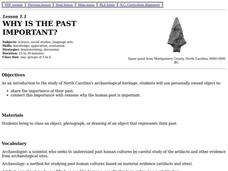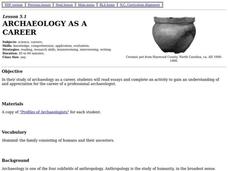Curated OER
Meet You at the Midden: Map Game
Students examine sketch map of Burrets' Trail at the Nightengale Archaeological Center, interpret map symbols to play game, and identify reasons people modify environment to meet their basic needs.
Curated OER
Plants in Texas: Then and Now
Seventh graders discuss continuity and change, identify various plant materials, and compare and contrast ways in which early people used plants in Texas in prehistoric times with ways that modern man in Texas uses plants today.
Curated OER
Geography and Archeology of the River People
Seventh graders work together in groups to read a handout and answer questions about the geography and archeology of a group of native peoples. As a class, they discuss their opinions and answers and the importance of using artifacts to...
Curated OER
Tag It and Bag It: Archeology Lab Lesson
Seventh graders practice analyzing, collecting and categorizing artifacts. Using charts, they organize and interpret information about the artifacts they classified. They work together to create a graph to represent class totals and...
Curated OER
Vocabulary Charts
Seventh graders are introduced to the vocabulary associated with archeology. Using a dictionary, they practice finding the meaning of various words and create sentences. They also identify an appropriate use of the word and draw an...
Curated OER
Investigating Pot Sherds
Sixth graders measure pot sherds and use their knowledge of Pi to infer possible uses of pottery. They also infer possible functions of ancient ceramics. After tracing rounded pottery pieces onto paper, 6th graders use compasses to...
Curated OER
Trekking to Timbuktu
Students view a television show to provide a context for conducting research into the location and culture of Timbuktu. The students complete a report on the subject in the form of a research paper.
Curated OER
Archaeological Finds
Students demonstrate the goals and methods of archaeology and write a report of an archaeological dig at a site associated with a specific culture. They explore the science of archaeology and how it contributes to the understanding of...
Curated OER
Archaeology of Utah
Fourth graders investigate the significance of rock art and archaeology of Utah. They listen to the books "Before You Came This Way" and "When Clay Sings," and write a story and create an illustration about rock art.
Curated OER
Leaarn to Think Like an Archaeologist
Students examine how to act as archaeologists by examining artifacts. The inquiry is meant to teach learners about analysis of ancient civilizations and scientific finds. Fossil evidence is also covered to make connection to the...
Curated OER
Becoming a Louisiana Archaeologist
Learners examine pieces of pottery as they role play archaeologists. They use cutouts and examine them for markings. They complete a worksheet to end the lesson.
Curated OER
Ethics in Archeology
Students discuss their views about archeological site protection. They analyze different dilemmas dealing with this issue and discuss. They discover the importance of protecting artifacts and archeological sites.
Curated OER
The Pottery Project
Students research Native American culture regions and archaeology techniques. In small groups, they decorate a clay pot, break the pots, and repair and analyze the designs on the pottery.
Curated OER
Dig This
Fifth graders explore the work of paleontologists and the life of dinosaurs and create a sculpture of the bones of a Stegosaurus. The sculpture was then buried and used by other classes for a dig.
Curated OER
Why is the Past Important?
Fourth graders discuss the importance of North Carolina's archaeological heritage. They share with the class an object, photograph, or drawing of an object that represents their own or their family's past.
Curated OER
Take Action, Save the Past
Eighth graders use their creative and critical thinking skills to find useful solutions to current and future problems concerning the destruction of archaeological sites and artifacts.
Curated OER
Archaeology as a Career
Fourth graders read about archaeology as a career. They develop a list of questions they would like to ask an archaeologist and then actually interview an archaeologist on the future of archaeology as a career.
Curated OER
Stratigraphy and Cross-Dating
Students interpret archaeological strata using the law of superposition. They apply cross-dating to determine the age of other artifacts.
Curated OER
Clues to the Past
Students analyze how arhaeologists study the past. They define basic archaeological terms, make general inferences from observations, and explain the importance of context.
Curated OER
Why Archaeologists Dig Square Holes
Students examine how archaeologists establish and maintain the context of artifacts. They interpret a plan view of an archaeological site and explain the importance of the grid system.
Curated OER
Pottery Analysis
Students study how archaeologists analyze artifacts to answer questions about past cultures. They explain why pottery is important to archaeologists and how they use classification to answer their research questions.
Curated OER
Lesson 4: A Field Trip to the Maine State Museum
Students analyze the Maine State Museum's exhibit 12,000 Years in Maine. They create an artifact and write a description of that artifact that demonstrates their understanding of the way technology shapes culture.
Curated OER
"it's All in the Cellar"
Seventh graders examine the process of constructing a site plan map at archaeological sites. They discuss the process of mapping techniques and calculation of percentages, create a plan site map of a cellar at Jamestown, and calculate...
Curated OER
"How to Think Like an Archaeologist" - Suggested Pre-Visit Activity For Historic Jamestown
Learners examine how archaeologists use artifacts to explore other people and their cultures. They discuss types of artifacts, analyze receipts for clues, and discuss how what the items bought reflect about people.




